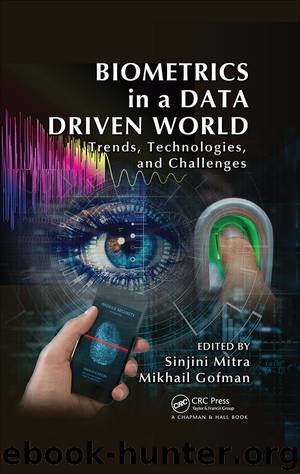Biometrics in a Data Driven World by Sinjini Mitra & Mikhail Gofman

Author:Sinjini Mitra & Mikhail Gofman
Language: eng
Format: epub
Publisher: CRC Press
Published: 2016-11-30T16:00:00+00:00
6.2.3.3.1 Neurofeedback
Lubar et al. (1976) originally showed that neurofeedback training could significantly reduce seizure intensity and duration for epilepsy patients, when they focused on increasing the 12–14 Hz activity of EEG referred to as sensorimotor rhythm (SMR). Further research showed similar success in reducing symptoms for seizure patients (Sterman, 2000; Heinrich et al., 2007), and neurofeedback training began to be explored to treat other conditions. Monastra et al. (1999) showed that participants with ADHD have a distinctive difference in their brain activity compared to people without ADHD. Specifically, they showed that people diagnosed with ADHD have significantly higher levels of slow wave (i.e., theta, 4–8 Hz) in relation to fast wave (i.e., beta, 13–21 Hz) EEG activity. Research focused especially on children with ADHD used different training mechanisms, that is, suppressing or increasing activity in different frequency bands (e.g., SMR, theta, and beta) to try to help children learn to self-regulate their brain activity (e.g., Lubar and Lubar, 1984; Lubar et al., 1995; Heinrich et al., 2007; Gevensleben et al., 2009; Bakhshayesh et al., 2011; Moriyama et al., 2012; Steiner et al., 2014). The results showed that people who were able to change their brain activity through neurofeedback training also showed significant improvements along several other metrics: their performance on attention tests and intelligence tests increased, behavioral ratings improved, and feedback from parents and teachers was positive (Lubar et al., 1995; Kaiser and Othmer, 2000; Monastra et al., 2002). Neurofeedback training has proven itself effective not just in case studies, but also in large-scale studies in treating attentional dysfunction (Kaiser and Othmer, 2000). The results of neurofeedback training also seem to be sustainable, as shown by follow-up studies after years without continued neurofeedback training (Monastra et al., 2006). One study demonstrated the positive effect of neurofeedback training with school children that were taking medication to treat the symptoms of ADHD. The positive effect of the altered brain activity was sustained even when the medication was discontinued (Monastra et al., 2002).
In addition to helping people with different medical conditions modulate brain their activity, neurofeedback training also showed positive results when used for healthy people who were not diagnosed with a medical condition (Kaiser and Othmer, 2000; Vernon, 2005; Heinrich et al., 2007; Nan et al., 2012). For example, to determine whether neurofeed-back training could result in improvements in areas such as memory or performance in sports or artistic activities, Vernon (2005) documented that by training healthy subjects to modulate their SMR/beta and SMR/theta ratios, they were able to observe improvements in semantic working memory. Other researchers showed that by increasing the low frequency activity in the left hemisphere, the targeting ability in pre-elite archers improved significantly (Landers et al., 1991). Finally, researchers showed that the performance of a dancer could be improved with neurofeedback training (Raymond et al., 2005). For a more detailed review of the possibilities of neurofeedback training, see Vernon (2005).
Download
This site does not store any files on its server. We only index and link to content provided by other sites. Please contact the content providers to delete copyright contents if any and email us, we'll remove relevant links or contents immediately.
Algorithms of the Intelligent Web by Haralambos Marmanis;Dmitry Babenko(8522)
Test-Driven Development with Java by Alan Mellor(7407)
Data Augmentation with Python by Duc Haba(7301)
Principles of Data Fabric by Sonia Mezzetta(7049)
Learn Blender Simulations the Right Way by Stephen Pearson(6986)
Microservices with Spring Boot 3 and Spring Cloud by Magnus Larsson(6807)
RPA Solution Architect's Handbook by Sachin Sahgal(6219)
Hadoop in Practice by Alex Holmes(6031)
The Infinite Retina by Robert Scoble Irena Cronin(5918)
Jquery UI in Action : Master the concepts Of Jquery UI: A Step By Step Approach by ANMOL GOYAL(5873)
Big Data Analysis with Python by Ivan Marin(5721)
Life 3.0: Being Human in the Age of Artificial Intelligence by Tegmark Max(5403)
Pretrain Vision and Large Language Models in Python by Emily Webber(4684)
Infrastructure as Code for Beginners by Russ McKendrick(4464)
WordPress Plugin Development Cookbook by Yannick Lefebvre(4195)
Functional Programming in JavaScript by Mantyla Dan(4124)
The Age of Surveillance Capitalism by Shoshana Zuboff(4116)
Embracing Microservices Design by Ovais Mehboob Ahmed Khan Nabil Siddiqui and Timothy Oleson(3982)
Applied Machine Learning for Healthcare and Life Sciences Using AWS by Ujjwal Ratan(3959)
